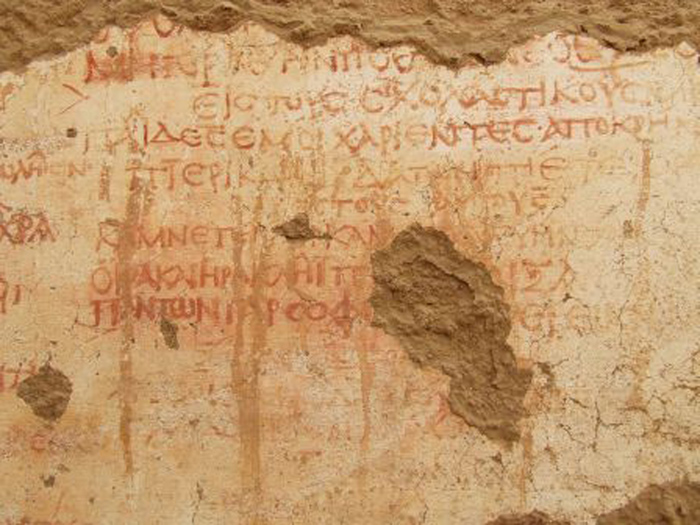Drug References Found on Walls of Ancient Egyptian School

Archaeologists working in the western desert of Egypt have discovered a school dating back about 1,700 years that contains ancient Greek writings on its walls, including a text about ancient drug use that references Homer's "The Odyssey."
The school — which contains benches that students could sit on to read, or stand on and write on the walls — dates back to a time when the Roman Empire controlled Egypt, and Greek was widely spoken.
In use for less than 20 years, the school structure eventually became part of a large house that contained colorful art, including images of the Olympian gods, the researchers said. [See Photos of the Ancient Egyptian School and Texts]
The house and school are located in the ancient town of Trimithis (modern-day Amheida), which is in the Dakhla Oasis, about 200 miles (322 kilometers) west of the Nile River. The house, and some of the art, was first discovered in 1979. In 2001, a new exploration project at Amheida, now sponsored primarily by New York University, led to the discovery of the school, its Greek writings and more art scenes from the house.
A unique discovery
In the ancient world, schools were often part of other places — like private residences, city halls or temples — and, as such, are very difficult for archaeologists to identify, Raffaella Cribiore, a professor at New York University, wrote in the journal Zeitschrift für Papyrologie und Epigraphik (a journal that publishes ancient texts).
Although archaeologists know of another ancient school in Egypt — a university in Alexandria — the school at Amheida is unique because it was found with texts on its walls, Cribiore said. The texts are "further proof that teaching and learning took place there, and confirm that they belong to the only building so far discovered from antiquity that was certainly a school and showed educational activities," Cribiore wrote.
Get the world’s most fascinating discoveries delivered straight to your inbox.
For instance, The text referring to "The Odyssey" tells a legendary story of ancient drug use: Helen of Troy, for whom the Trojan War had been fought, gives her guests a drug (possibly opium) that "takes away grief and anger, and brings forgetfulness of every ill," the text reads. "Whoever should drink this down when it is mixed in the bowl would not let fall a tear down his cheek in the course of that day at least. Imitate." The word "imitate" appears to indicate the students should copy the passage in some way. Ancient records say that some people believed this passage had a magical quality to it that could calm young people. [In Photos: Two Black Magic Curse Tablets]
In a different room of the school, the team discovered another text composed by a teacher telling students to bring their rhetorical skills up to the level of several deities, including the ancient Greek god Hermes. It also urged the students to work hard. "Be bold, my boys; the great god will grant you to have a beautiful crown of manifold virtue," part of the text reads. "Work hard for me, toils make men manly …"
School's out
The school wasn't in use for long, perhaps because the teacher moved or died, the researchers said. During this era, "a school was a teacher and ceased to exist when the latter moved or died," Cribiore wrote. After it closed, the school building was incorporated into a nearby house belonging to a town councillor named Serenos, who used part of it for storage.
In 1979, researchers found a painting of the Olympian gods in Serenos' house, and recent excavations have revealed more paintings including one of a banquet scene with a flute player. In one room, almost every surface "was decorated, either with colourful geometric motifs or lively figural scenes, such that the experience of entering the space for the first time in antiquity must have been overwhelming," wrote Susanna McFadden, a professor at Fordham University, in a book titled "Actes du XII Colloque de l'Association International pour la Peinture Murale Antique." (The book is to be published by the L'Associazione internazionale per la pittura murale antica in the future.)
Serenos appears to have had an appreciation for the lessons conveyed at the school and kept the teacher's text urging students to work hard and elevate their rhetorical skills, Cribiore said. The occupants of the house probably "valued its appearance and content, which could appear as signs of their cultural sophistication," Cribiore wrote.
The text written by the teacher was first published in the 2008 edition of the Journal of Roman Archaeology.
Follow us @livescience, Facebook & Google+. Original article on Live Science.

Owen Jarus is a regular contributor to Live Science who writes about archaeology and humans' past. He has also written for The Independent (UK), The Canadian Press (CP) and The Associated Press (AP), among others. Owen has a bachelor of arts degree from the University of Toronto and a journalism degree from Ryerson University.



